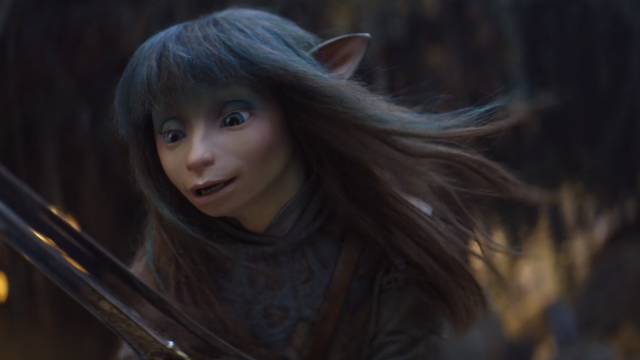Thanks to Marvel, we live in the post-credits sequence era, whether it’s at the cinema or on TV. But while most shows and movies are content with a little extra scene, a gag, or a teaser trailer for what’s to come, The Dark Crystal: Age of Resistance does something different.
This isn’t really a spoiler — there’s no story details here for Age of Resistance’s stellar first season. But it’s such a nice surprise that, if you don’t want to find out just what happens when the credits on the tenth and final episode roll, here’s your chance to turn back.
(Go finish Age of Resistance. It’s really good.)
When Rian, Deet, Brea and Hup’s journey comes to an end, you’re probably left with a bunch of burning questions about just what’s happened and where it could all go between here and the original Dark Crystal. But while Age of Resistance does have something that plays after the credits, it’s not really a post-credits scene that could answer some of those questions.
Because it’s an hour and 23 minutes long. And it’s a full-length, behind the scenes documentary called The Crystal Calls: Making The Dark Crystal: Age of Resistance.
Directed by Randall Lobb and produced by Definitive Film, the documentary might not be a comprehensive story-beat breakdown of what you’ve just watched occur on Thra, but it helps to answer at least one of your likely questions: how the hell did this show about puppet fantasy creatures actually get made?
The answer, The Crystal Calls finds, is with a lot of hard work and crafstmanship. Oh, and occasionally putting on a backpack that’s approximately 30-odd pounds’ worth of Skeksis puppet.
In the journey to find that answer, The Crystal Calls has some truly incredible little nuggets of information bound to have Dark Crystal fans salivating with delight.
Everything from gorgeous, up-close examinations of the mechanical skeletons of the puppets themselves, to the graphic design behind Brea’s notebook (a key item in Age of Resistance), is given lavish attention by The Crystal Calls’ lens.
Beyond that, there’s also multiple intriguing looks at what the show could have been in another timeline: proof of concept visuals from the test footage the Henson Company pitched Netflix with where the show was primarily CG animated, featuring a puppeteered Skeksis chasing an entirely CG Gelfling, before the decision was made to make Age of Resistance a primarily-practical show.
Throughout, there’s never a sense of the documentary taking the easy way out and belittling modern reliance on CG in order to praise the handcrafted approach, either. If anything, The Crystal Calls takes the time to acknowledge the importance CG enhancement brought to the show, from green screen backdrops, to blue puppeteer suits letting bold design choices like Lore the stone guardian get realised as a practical, tangible thing.
But you also you get to see the sheer depth of passion that went into bringing Age of Resistance to life, directly from the people who had a hand in it. Featuring interviews not just with the voice actors, writers, and producers behind the series, The Crystal Calls rightfully highlights the work of every discipline that went into making the show, from puppeteers to graphic designers, from prop builders to set designers, from people like composer Daniel Pemberton to Joe M. Lee, the novelist who not just wrote several Dark Crystal prequel books, but helped craft the Podling language used on the show.
Every facet of production isn’t just represented, but embraced. The importance of each and every one of these people is never devalued or understated — the word of a star like Taron Egerton, the voice of Rian, is given as much weight in The Crystal Calls as the word of Neil Sterenberg, the puppeteer behind Rian, and is in turn given to someone like producer and writer Javier Grillo-Marxuach.
Aside from that abiding respect for the people involved, what’s clear from those interviews is the love these people have for the world they’re working in. Egerton perhaps stands out as perhaps one of the most excitable — gleefully relishing as he reminiscences falling love with the original movie, the moment he got to be part of this follow up, and the artistry on display. But the legacy of what Age of Resistance represents as a generational passing of the torch is best represented in The Crystal Calls by two families vital to Thra: the Hensons and the Frouds.
The former is represented through Age of Resistance producer Lisa Henson and her sister Cheryl, president of the Jim Henson Foundation, who both talk with warmth about the work their father did and what he would think of the new show.
But the Frouds — concept designer Brian, puppet-maker Wendy, and their son, Toby Froud, a design supervisor and also, yes, the baby from Labyrinth — in particular get to physically embody that pan-generational crossing of barriers Age of Resistance is, as we watch them work together, and in Brian and Wendy’s case, look back on their groundbreaking work for the original as they see their son and so many others carry it on alongside them for the new series.
I’m dying to see what could lie ahead for Age of Resistance, but for now The Crystal Calls is the perfect end-cap to watching this season, a perfectly placed reminder that the magic you’ve just watched unfold is the dedicated work of hundreds of immensely driven people.
While you could just search for it directly on Netflix, choosing to have it automatically loop in as the credits on Age of Resistance’s final episode roll is perhaps the best way to see it for the first time: it catches you at just the best moment. “How did this even get made,” you ask, as those credits play for one last time.
“Well, here’s how,” The Crystal Calls answers. And it answers so beautifully.
